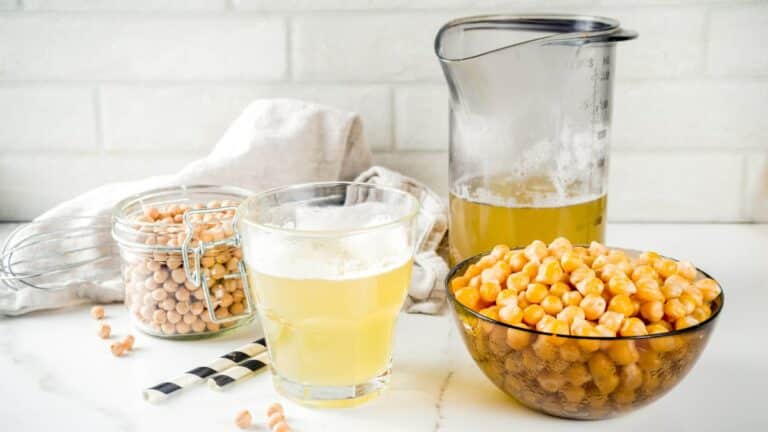Table of Contents
Aquafaba is one of the most versatile and incredible ingredients in recent years. It is an excellent egg replacer and incredibly healthy, packed full of protein and nutrients, and perfect for vegans and non-vegans alike. But the question on everyone’s lips is whether this magical ingredient is genuinely vegan or not?
In this comprehensive guide, we’ll take a closer look at what aquafaba is, why it’s called that, its nutritional benefits, and more. We’ll also explore whether aquafaba is vegan, how to use it to make delicious dishes, and other fascinating facts about this incredible ingredient.
Related: Is Soy Lecithin Vegan?
What is Aquafaba?
Aquafaba is the liquid that remains after cooking chickpeas or other legumes. It combines starch, protein, and other ingredients leached from the beans. When whipped, it forms a foam-like substance that is remarkably similar to whipped egg whites and can be used in many recipes to replace eggs and dairy.
Why is Chickpea Water Called Aquafaba?
The term aquafaba was coined in 2015 by Goose Wohlt, who created a Facebook group to explore the phenomenon. The name comes from the Latin terms aqua (water) and faba (beans). Aquafaba was initially discovered by Joël Roessel, a French chef, who noticed he could use the liquid from cans of chickpeas as a vegan substitute for whipped egg whites.
Is Aquafaba Vegan?
Yes, aquafaba is vegan. It is made entirely from plant-based ingredients and contains no animal products. It has become prevalent among vegans as an egg replacer in baking, where it can be used to make vegan meringues, macarons, and even vegan mayonnaise.
Is Aquafaba Good for You?
Yes, aquafaba is incredibly healthy! It is low in calories, protein and packed with nutrients. One serving of aquafaba (3 tablespoons) contains just 13 calories, 0.5g of fat, 2g of protein, and 0.5g of fiber. It’s also an excellent source of magnesium, potassium, and iron.
Is Aquafaba Paleo?
While aquafaba is a relatively new ingredient, it is not considered paleo. Paleo followers try to stick to a diet that mimics our Paleolithic ancestors, which means eating only whole, unprocessed foods. Aquafaba is a processed ingredient, and while it is derived from whole food (chickpeas), it is not considered paleo.
How to Cook Delicious Dishes with Aquafaba.
Aquafaba can be used in many ways in the kitchen. For baking, it can be whipped to make vegan meringues, macarons, and mayonnaise. It can also replace eggs in recipes such as pancakes, waffles, and omelets. For savory dishes, it can even be made into an egg-like texture used in recipes such as quiches or frittatas.
Conclusion
Aquafaba is a game-changer in the kitchen and an excellent ingredient for vegans and non-vegans alike. It’s incredibly versatile, healthy, and delicious, and best of all, it’s entirely vegan.
So whether you’re a seasoned vegan or just interested in exploring new ingredients, be sure to give aquafaba a try.

